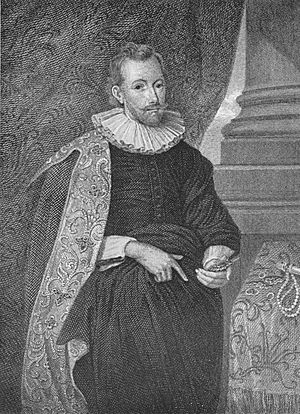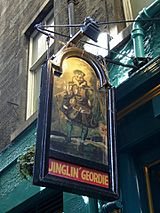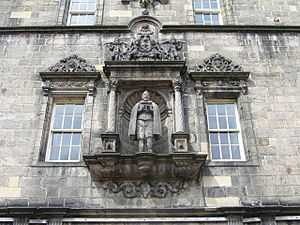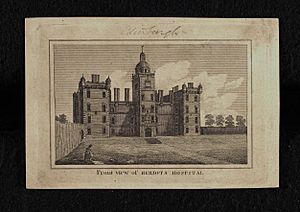George Heriot facts for kids
George Heriot (15 June 1563 – 12 February 1624) was a Scottish goldsmith and philanthropist. He is chiefly remembered today as the founder of George Heriot's School, a large independent school in Edinburgh; his name has also been given to Heriot-Watt University, as well as several streets (and a pub, the Jinglin' Geordie, after his nickname) in the same city.
Heriot was the court goldsmith to Anne of Denmark, the wife of King James VI of Scotland, as well as to the king himself; he became very wealthy from this position, and wealthier still as a result of lending this money back to the king and the rest of his court. He moved to London along with the court in 1603, at the time of the Union of Crowns, and remained in London until he died in 1624. He had married twice but had no recognised children surviving at the time of his death, and he left the bulk of his estate to found a hospital to care for "faitherless bairns" (orphaned children) in his home city.
Early life
Heriot was born on 15 June 1563, the eldest legitimate son of George Heriot, one of possibly as many as forty siblings. His mother is unknown. He was likely born in Corstorphine (a suburb of Edinburgh) or Edinburgh itself.
George's father was a well-established goldsmith from an old Haddingtonshire family, who served as a Member of the Parliament of Scotland.
On 14 January 1586 he was engaged to marry Christian Marjoribanks, the daughter of Simon Marjoribanks, a burgess of the city of Edinburgh and a local merchant. To mark the marriage, and the end of his apprenticeship, Heriot was given 1500 merks by his father to establish his own business, which he did in a small booth near St. Giles' Cathedral, on the site of the entrance of the Signet Library.
He was elected a burgess of the county of city of Edinburgh in January 1588, at the age of twenty-four, and in May that year was admitted to membership of the Edinburgh Incorporation of Goldsmiths. By October 1593, he had been elected Deacon of Goldsmiths.
Heriot owned a house on Fishmarket Close off the Royal Mile.
Goldsmith to the Crown
From early in the 1590s, Heriot had been selling items to Anne of Denmark, the Queen Consort, and on 17 July 1597, he was officially appointed the goldsmith to the Queen. The queen had previously employed a German jeweller Jacob Kroger. The role of a goldsmith in the early modern period extended beyond simply the making and trading of jewellery and precious metals; in effect, he had now become her banker. Over the following years, he lent her significant amounts of money, often secured on jewellery he himself had sold her. Anne's love of jewellery was "legendary", and by the late 1590s both she and the king were taking out significant loans to support their spending. This ensured Heriot's position would remain lucrative; it had been estimated that between 1593 and 1603 he may have done as much as £50,000 of business with the Queen.
James VI owed Heriot £6,720 for jewelry and precious stones in March 1599 and gave him a jewel as a pledge for payment, which included 74 diamonds and a larger diamond set in gold. In June 1599 James instructed his exchequer officers to repay from his tax receipts a loan advanced on the security of some of the queen's jewels. In August 1599 Heriot was paid £400 Sterling from the English annuity, a sum of money which Queen Elizabeth sent to Scotland, for jewels delivered to Anna of Denmark.
Heriot's financial involvement with the court grew stronger over the years; he was appointed jeweller to James VI in 1601, and became involved in a governmental plan to replace the circulating currency of Scotland. By 1603, he held the right to farm the customs.
In 1603, at the Union of the Crowns James VI inherited the English and Irish thrones, and ruled these kingdoms as King James I. He moved to London. Heriot, along with much of his court, followed suit. In November he was appointed a jeweller to the king, with an annual salary of £150. The English goldsmiths John Spilman and William Herrick were given similar appointments. The salary was a small amount in comparison to Heriot's sales and loans, and by 1609 Queen Anne's debt to him was £18,000, from which he drew a sizeable interest.
Surviving bills for jewellery supplied to Anna of Denmark mostly date from 1605 to 1615, totalling around £40,000. Her servants Margaret Hartsyde and Dorothy Silking often dealt with him on her behalf. She often wore a miniature portrait of Isabella Clara Eugenia and Heriot mended its locket case twice. Surviving pieces made by Heriot for Anne include a gold miniature case set with her initials in diamonds, now held by the Fitzwilliam Museum, which the queen may have gifted to her lady-in-waiting Anne Livingstone, and a pair of earrings which include the enamelled face of an African man, in a private collection. The earrings were itemised by Heriot in 1609 as "two pendants made as more's heads and all sett with diamonds price £70." They may reflect her fascination with the representation of African people in the theatre, as in her Masque of Blackness. Heriot also supplied jewels to Prince Henry.
After his wife Christian died, he returned to Edinburgh.
Heriot later married Alison Primrose, the daughter of James Primrose of Carington, the clerk to the Scottish Privy Council. The marriage was short-lived, as Alison died in 1612, and childless.
Heriot supplied a chain with 60 pieces each set with three small diamonds worth £250 to the king's favourite, the Earl of Somerset, which was returned to him in 1615 when the Earl was disgraced.
Heriot, with the other royal jewellers Abraham Harderet, William Herrick and John Spilman, joined the funeral procession of Anna of Denmark in 1619.
Heriot had a town house in the Strand and a country estate at Roehampton, and considerable property in Edinburgh.
Death and legacy
Heriot died in London in February 1624 and was buried at St. Martin-in-the-Fields, where the sermon was given by Walter Balcanquhall.
Heriot had at least three children by his first wife, Christian Marjoribanks: William (1595), Robert (1599), and John (1601). Two of them may have drowned at sea, although the exact details of their death are unknown.
He had no other legitimate children – his second marriage was childless – but in his will he left money to provide for two natural daughters Elizabeth Band (born 1613) then aged ten and Margaret Scott (born 1619) then aged four. There were additional bequests to his stepmother and his half-siblings, as well as his nieces and nephews. However, the residue of the estate, some £23,625, was left to the county of city of Edinburgh, to establish a hospital for the free education of the "puir, faitherless bairns" of deceased Edinburgh burgesses.
Heriot's Hospital was begun in 1628, and duly constructed outside the city walls of Edinburgh, immediately to the south of Edinburgh Castle, adjacent to Greyfriars Kirk. It was completed just in time to be occupied by Oliver Cromwell's forces during the English Civil War. The hospital opened in due course in 1659, with thirty pupils; its finances grew, and it took in other pupils in addition to the orphans for whom it was intended. In the 1880s, it began to charge fees; however, to this day it serves its charitable object, providing free education to a sizeable number of children of widows or widowers.
Memorials
A statue of Heriot stands within the quadrangle of the school, above the pend on the north entrance tower. This is by Robert Mylne the King's Master Mason. It bears a Latin inscription which translates as: "This statue shows my body, this building shows my soul".
George Heriot is one of the carved figures on the Scott Monument on Princes Street. His figure, which stands on the lower tier of the south-west buttress, was carved by Peter Slater. He is depicted holding a model of the school.
In literature
George Heriot features as one of the two ghosts in Robert Fergusson's poem The Ghaists: A Kirk-Yard Ecologue (1773). He appears as a character in the novel The Fortunes of Nigel by Sir Walter Scott.
| Article contributor: Ray Harriot. Ray is a Historian of the Herriott Heritage Association and the author of “Beyond Trabroun: The Heriots of Scotland (1400-1700)” and “A Historical Perspective: The Heriot and Herriott Families of South Carolina”. |
See also
- William Fettes, another Edinburgh businessman, after whom Fettes College is named.
- List of universities named after people






